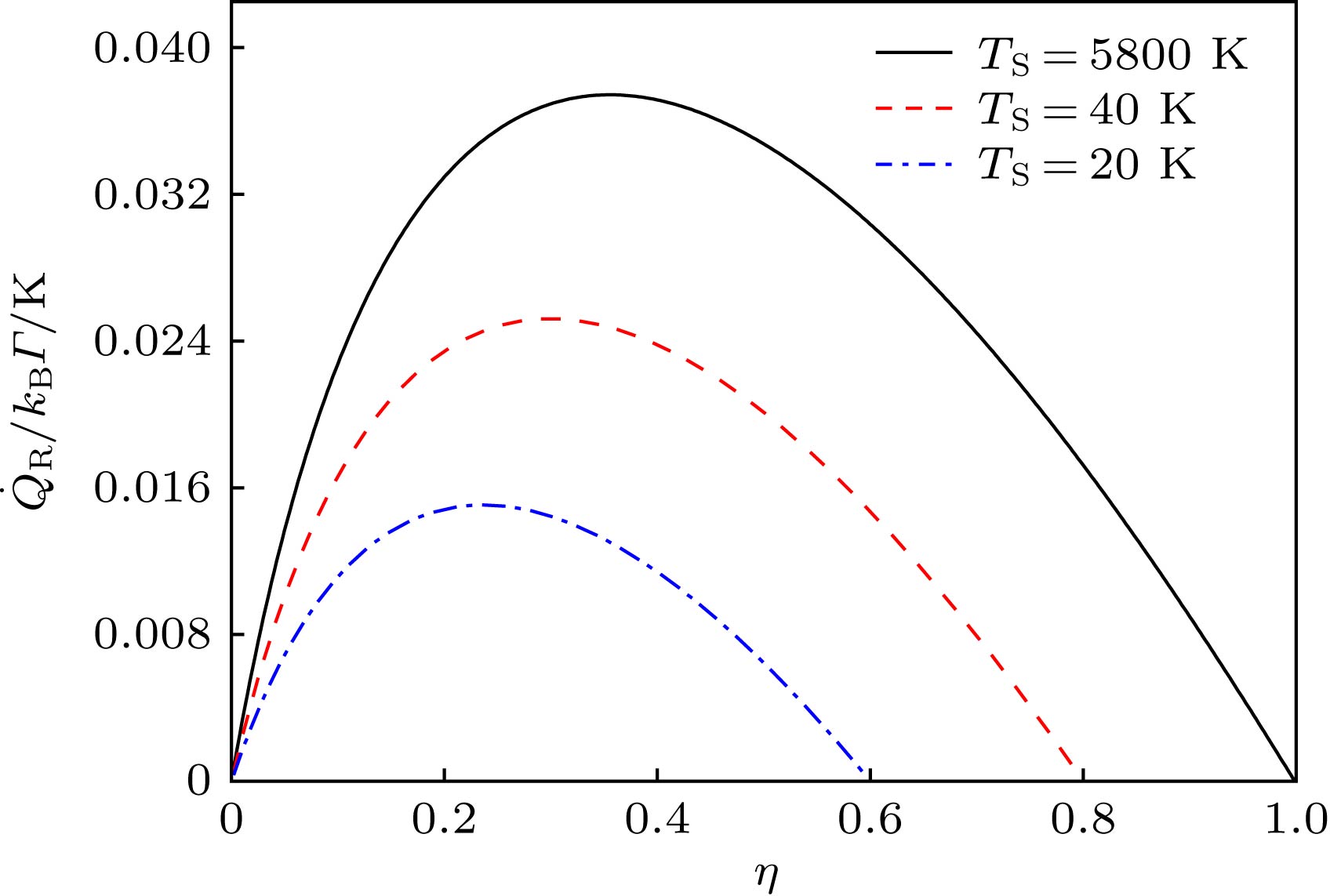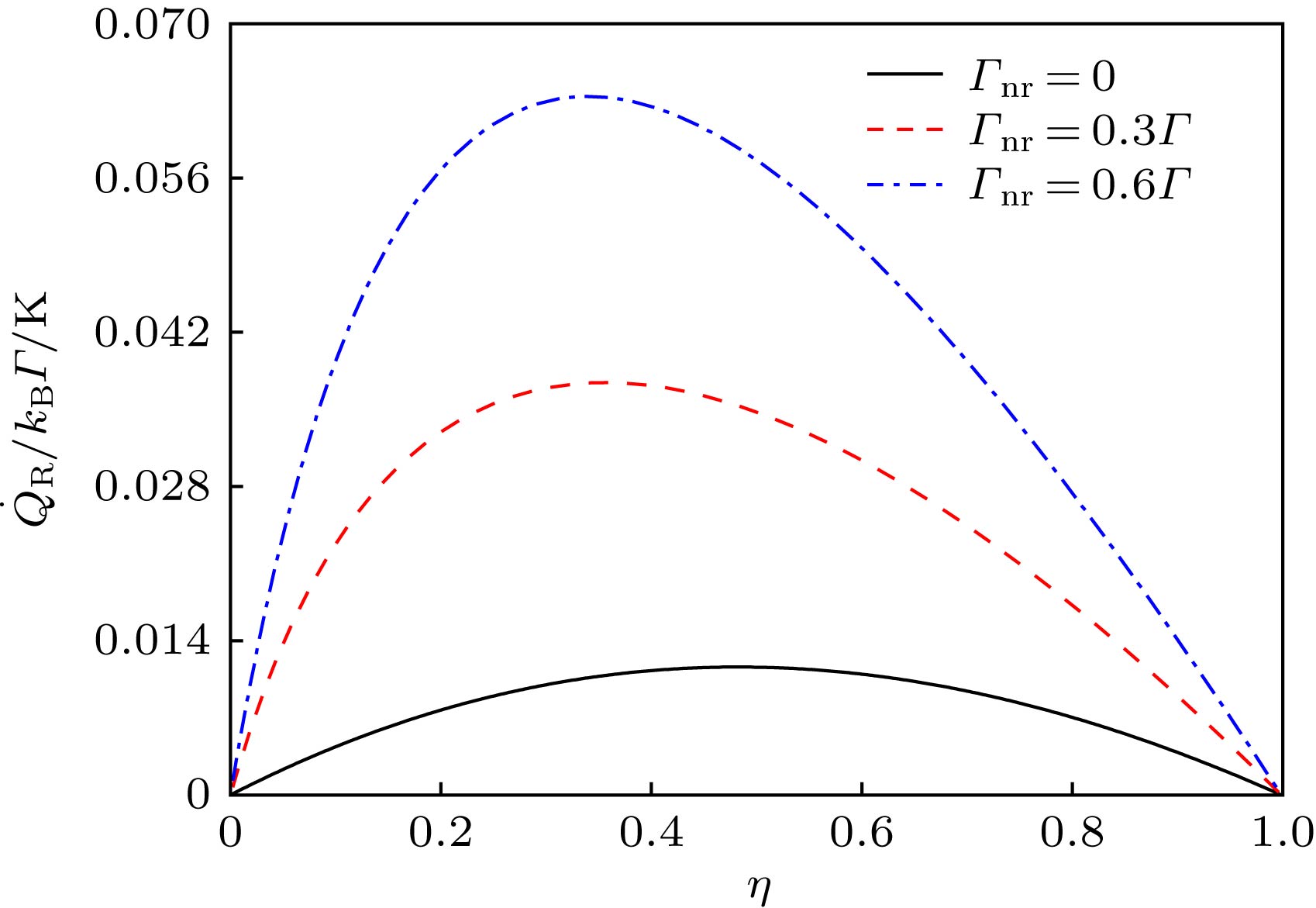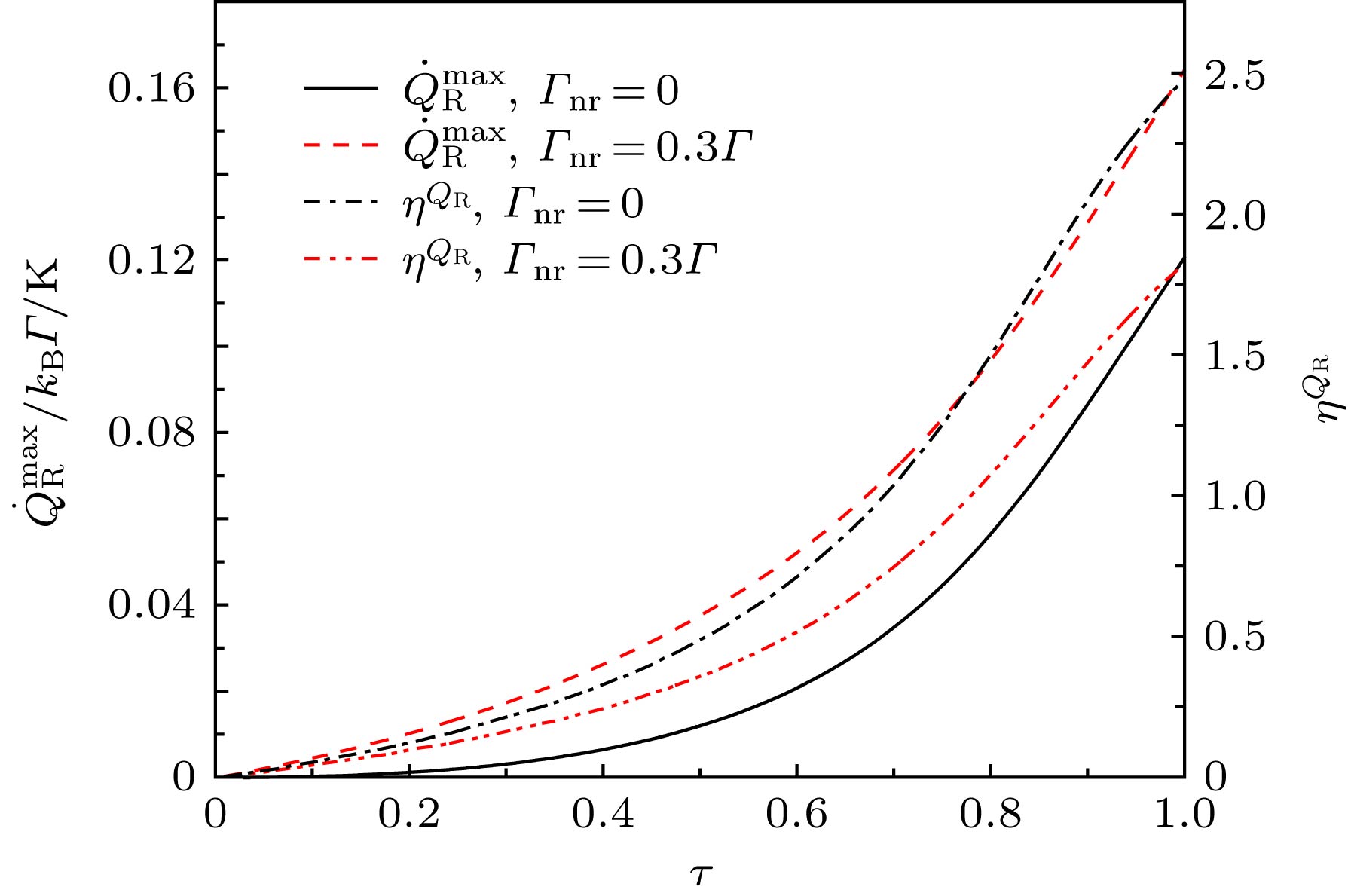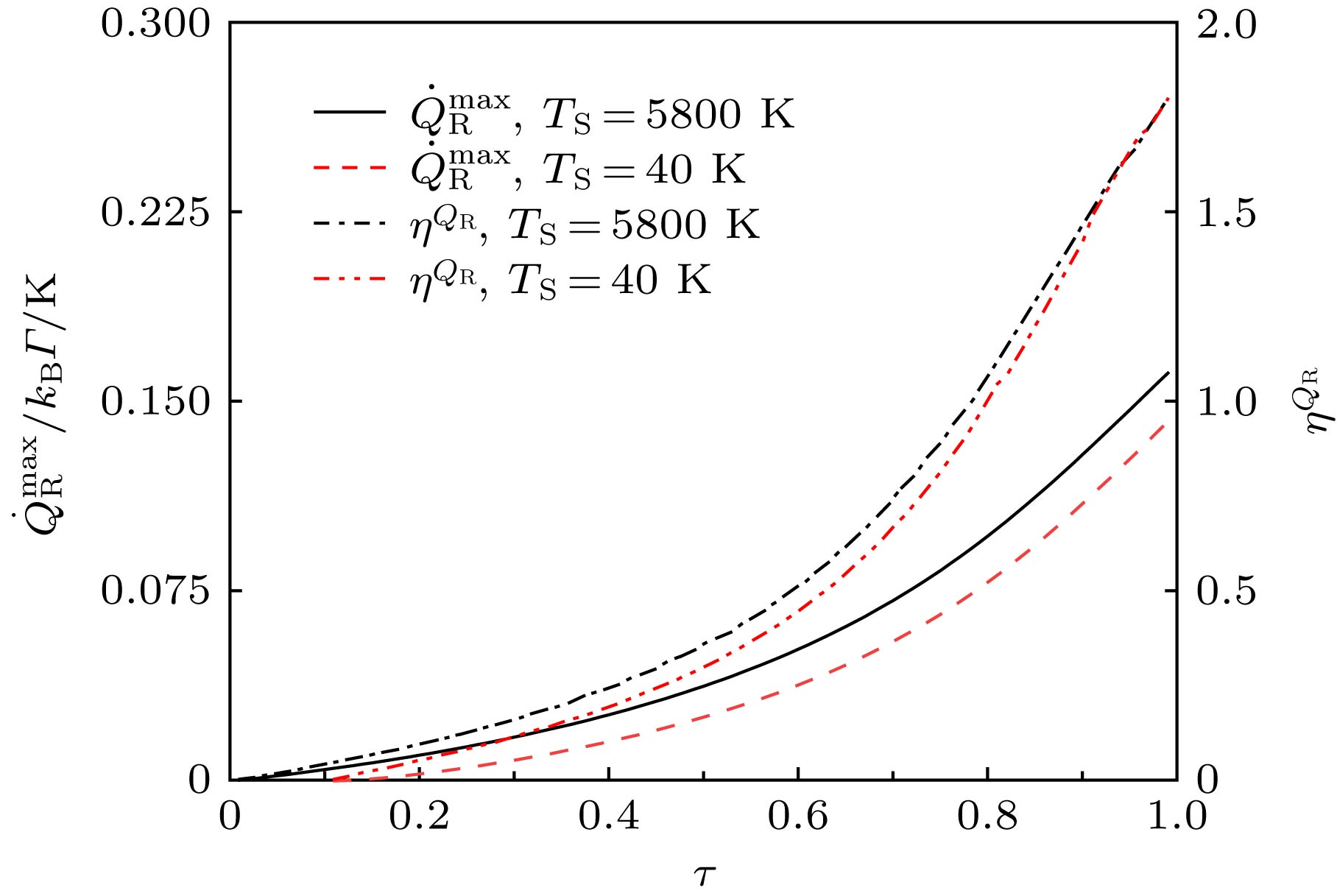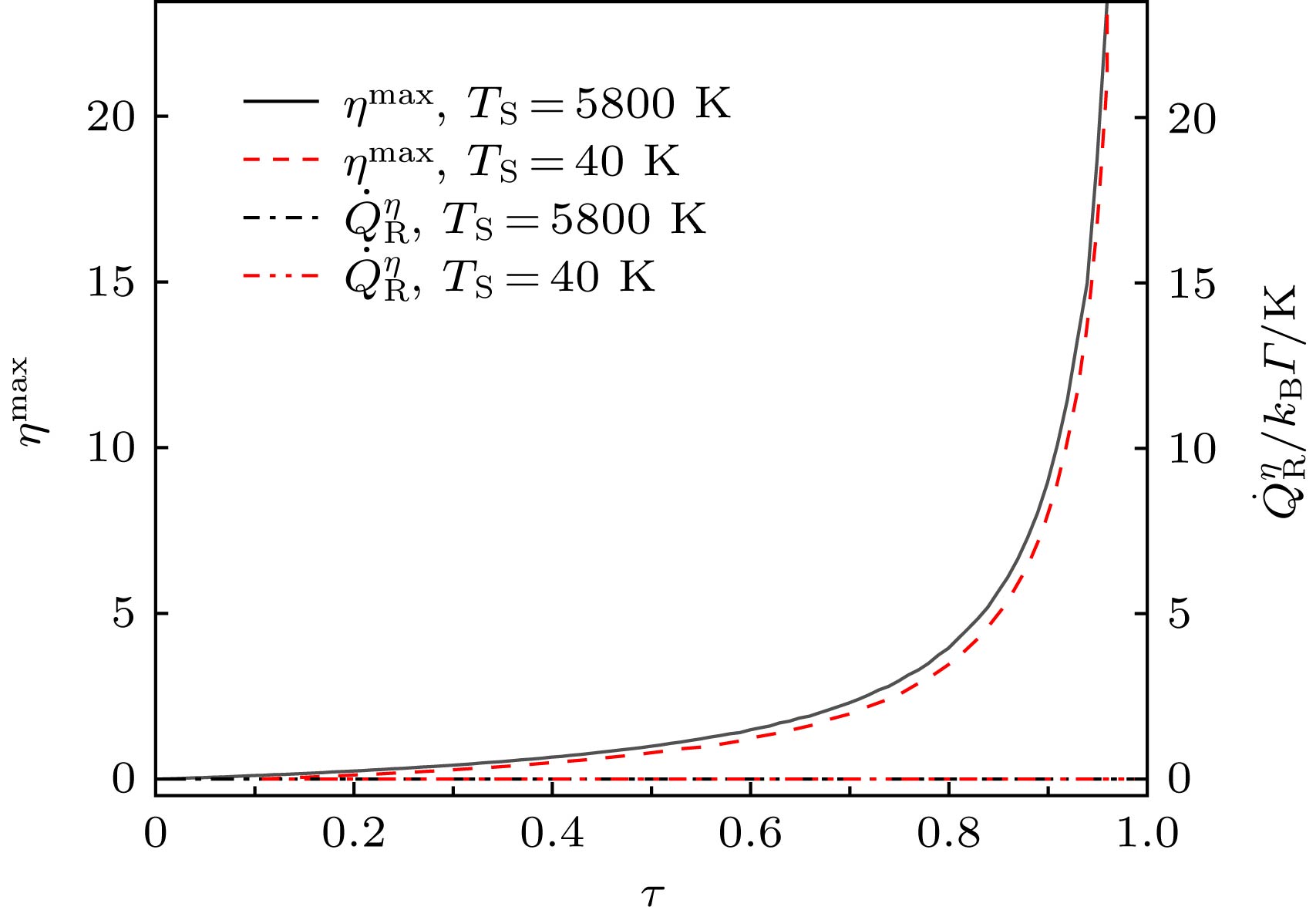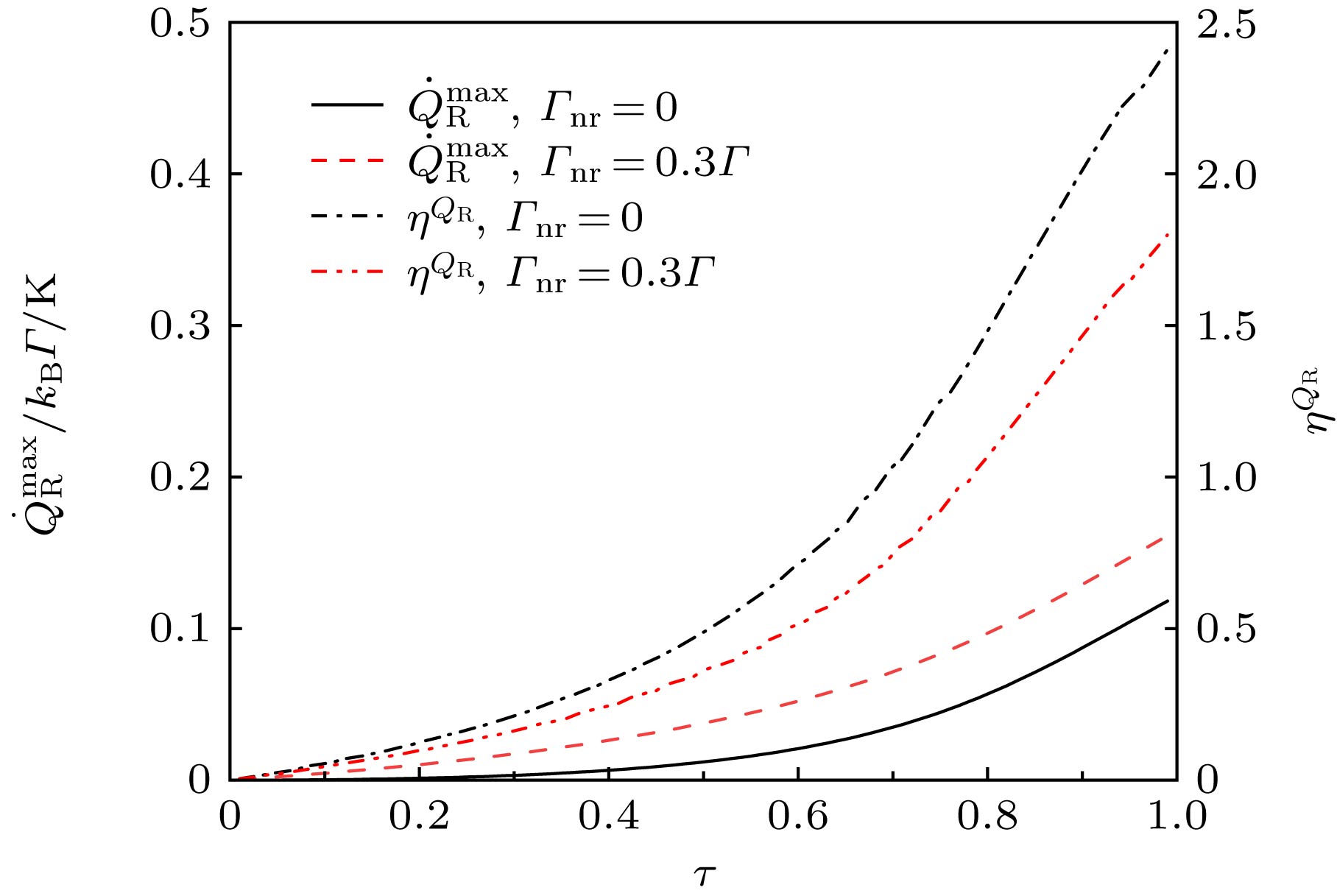-
A model of quantum dot refrigerator driven by photon, which consists of two two-level quantum dots, a photon reservoir and two leads, is proposed in this paper. Comparing with previous studies, we consider the transitions of electrons between different energy levels in a single quantum dot, which is more practical.Based on the theory of master equation and the assumption of weak coupling, we derive the expression of the cooling rate and the coefficient of performance of the refrigerator and obtain the condition of the tight coupling of the refrigerator operation. Next, we plot numerically the performance characteristic curves between the cooling rate and the coefficient of performance in the case of the tight coupling and in the general case. We find that the curves between the cooling rate and the coefficient of performance are opened loops for tight coupling, but they are closed loops in the general case. And we gain the conclusions that the refrigerator can be reversible under the condition of the tight coupling, while it can be irreversible in the general case. Then the optimally operating range of the refrigerator is determined. Finally, the effect of the temperature of the photon reservoir, transition coefficient, and temperature ratio on the performance of refrigerator under the conditions of the maximum cooling rate are studied, and also the coefficient of performance under the maximum cooling rate, the maximum coefficient of performanceand the cooling rate under the maximum coefficient of performanceare analyzed in detail.
-
Keywords:
- irreversible thermodynamics /
- quantum dot /
- thermoelectric refrigerator /
- performance optimization
[1] Giazotto F, Heikkila T T, Luukanen A, Savin A M, Pekola J P 2006 Rev. Mod. Phys. 78 217
 Google Scholar
Google Scholar
[2] Koumoto K, Mori T 2013 Thermoelectric Nanomaterials: Materials Design and Applications (Vol. 182) (Berlin: Springer Press) pp255-285
[3] Maciá E 2015 Thermoelectric Materials: Advances and Applications (Jenny: Stanford Publishing)
[4] Pichanusakorn P, Bandaru P 2010 Mater. Sci. Eng. R 67 19
 Google Scholar
Google Scholar
[5] Benenti G, Casati G, Saito K, Whitney R S 2017 Phys. Reports 694 1
 Google Scholar
Google Scholar
[6] Sothmann B, Sánchez R, Jordan A N 2014 Nanotechnology 26 032001
 Google Scholar
Google Scholar
[7] Sánchez R, Büttiker M 2011 Phys. Rev. B 83 085428
 Google Scholar
Google Scholar
[8] Dare A M, Lombardo P 2017 Phys. Rev. B 96 115414
 Google Scholar
Google Scholar
[9] Zhang Y C, Gin G X, Chen J C 2015 Phys. Rev. E 91 052118
 Google Scholar
Google Scholar
[10] Sothmann B, Sánchez R, Jordan A N, Büttiker M 2012 Phys. Rev. B 85 205301
 Google Scholar
Google Scholar
[11] Zhang Y C, Zhang X, Ye Z L, Gin G X, Chen J C 2017 Appl. Phys. Lett. 110 153501
 Google Scholar
Google Scholar
[12] Jordan A N, Sothmann B, Sánchez R, Buttiker M 2013 Phys. Rev. B 87 075312
 Google Scholar
Google Scholar
[13] Prance J R, Smith C G, Griffiths J P, Chorley S J, Anderson D, Jones G A C, Farrer I, Ritchie D A 2009 Phys. Rev. Lett. 102 146602
 Google Scholar
Google Scholar
[14] Sothmann B, Sánchez R, Jordan A N, Büttiker M 2013 N. J. Phys. 15 095021
 Google Scholar
Google Scholar
[15] Choi Y J, Jordan A N 2015 Physica E 74 465
 Google Scholar
Google Scholar
[16] Su S H, Zhang Y C, Chen J C, Shih T M 2016 Sci. Rep. 6 21425
 Google Scholar
Google Scholar
[17] Wohlman O E, Imry Y, Aharony A 2015 Phys. Rev. B 91 054302
 Google Scholar
Google Scholar
[18] Szukiewicz B, Eckern U, Wysokinski K I 2016 New J. Phys. 18 023050
 Google Scholar
Google Scholar
[19] Whitney R S, Sánchez R, Haupt F, Splettstoesser J 2016 Physica E 75 257
 Google Scholar
Google Scholar
[20] Lim J S, Sanchez D, Lopez R 2018 New J. Phys. 20 023038
 Google Scholar
Google Scholar
[21] Walldorf N, Jauho A P, Kaasbjerg K 2017 Phys. Rev. B 96 115415
[22] Jiang J H, Entin-Wohlman O, Imry Y 2013 New J. Phys. 15 075021
 Google Scholar
Google Scholar
[23] Su H, Shi Z C, He J Z 2015 Chin. Phys. Lett. 32 100501
 Google Scholar
Google Scholar
[24] Lin Z B, Li W, Fu J, Yang Y Y, He J Z 2019 Chin. Phys. Lett. 36 060501
 Google Scholar
Google Scholar
[25] Josefsson M, Svilans A, Burke A M, Hoffmann E A, Fahlvik S, Thelander C, Leijnse M, Linke H 2018 Nature Nanotechnol. 13 920
 Google Scholar
Google Scholar
[26] Thierschmann H, Sanchez R, Sothmann B, Arnold F, Heyn C, Hansen W, Buhmann H, Molenkamp L W 2015 Nature Nanotechnol. 10 854
 Google Scholar
Google Scholar
[27] Roche B, Roulleau P, Ulien T J, Jompol Y, Farrer I, Ritchie D A, Glattli D C 2015 Nature Commun. 6 6738
 Google Scholar
Google Scholar
[28] Hartmann F, Pfeffer P, Hofling S, Kamp M, Worschech L 2015 Phys. Rev. Lett. 114 146805
 Google Scholar
Google Scholar
[29] Cleuren B, Rutten B, van den Broeck C 2012 Phys. Rev. Lett. 108 120603
 Google Scholar
Google Scholar
[30] Levy A, Alicki R, Kosloff R 2012 Phys. Rev. Lett. 109 248901
 Google Scholar
Google Scholar
[31] Wang J H, Lai Y M, Ye Z L, He J Z, Ma Y L, Liao Q H 2015 Phys. Rev. E 91 050102
 Google Scholar
Google Scholar
[32] van den Broeck C 2005 Phys. Rev. Lett. 95 190602
 Google Scholar
Google Scholar
[33] Yuan Y, Wang R, He J Z, Ma Y L, Wang J H 2014 Phys. Rev. E 90 052151
 Google Scholar
Google Scholar
[34] Sheng S Q, Tu Z C 2014 Phys. Rev. E 89 012129
 Google Scholar
Google Scholar
-
图 7 在不同跃迁系数
${\varGamma _{n{\rm{r}}}}$ 下, 两个优化性能参数${\dot Q}_{\rm{R}}^{\max }$ 和${\eta ^{{Q_{\rm{R}}}}}$ 随着温比的变化Fig. 7. The curves of two optimal performance parameters
${\dot Q}_{\rm{R}}^{\max }$ and${\eta ^{{Q_{\rm{R}}}}}$ changing with the temperature ratio at different transition coefficient${\varGamma _{n{\rm{r}}}}$ 图 9 在不同跃迁系数
${\varGamma _{n{\rm{r}}}}$ 下, 两个优化性能参数${\dot Q}_{\rm{R}}^{\max }$ 和${\eta ^{{Q_{\rm{R}}}}}$ 随着温比的变化Fig. 9. The curves of two optimal performance parameters
${\dot Q}_{\rm{R}}^{\max }$ and${\eta ^{{Q_{\rm{R}}}}}$ changing with the temperature ratio at different transition coefficient${\varGamma _{n{\rm{r}}}}$ . -
[1] Giazotto F, Heikkila T T, Luukanen A, Savin A M, Pekola J P 2006 Rev. Mod. Phys. 78 217
 Google Scholar
Google Scholar
[2] Koumoto K, Mori T 2013 Thermoelectric Nanomaterials: Materials Design and Applications (Vol. 182) (Berlin: Springer Press) pp255-285
[3] Maciá E 2015 Thermoelectric Materials: Advances and Applications (Jenny: Stanford Publishing)
[4] Pichanusakorn P, Bandaru P 2010 Mater. Sci. Eng. R 67 19
 Google Scholar
Google Scholar
[5] Benenti G, Casati G, Saito K, Whitney R S 2017 Phys. Reports 694 1
 Google Scholar
Google Scholar
[6] Sothmann B, Sánchez R, Jordan A N 2014 Nanotechnology 26 032001
 Google Scholar
Google Scholar
[7] Sánchez R, Büttiker M 2011 Phys. Rev. B 83 085428
 Google Scholar
Google Scholar
[8] Dare A M, Lombardo P 2017 Phys. Rev. B 96 115414
 Google Scholar
Google Scholar
[9] Zhang Y C, Gin G X, Chen J C 2015 Phys. Rev. E 91 052118
 Google Scholar
Google Scholar
[10] Sothmann B, Sánchez R, Jordan A N, Büttiker M 2012 Phys. Rev. B 85 205301
 Google Scholar
Google Scholar
[11] Zhang Y C, Zhang X, Ye Z L, Gin G X, Chen J C 2017 Appl. Phys. Lett. 110 153501
 Google Scholar
Google Scholar
[12] Jordan A N, Sothmann B, Sánchez R, Buttiker M 2013 Phys. Rev. B 87 075312
 Google Scholar
Google Scholar
[13] Prance J R, Smith C G, Griffiths J P, Chorley S J, Anderson D, Jones G A C, Farrer I, Ritchie D A 2009 Phys. Rev. Lett. 102 146602
 Google Scholar
Google Scholar
[14] Sothmann B, Sánchez R, Jordan A N, Büttiker M 2013 N. J. Phys. 15 095021
 Google Scholar
Google Scholar
[15] Choi Y J, Jordan A N 2015 Physica E 74 465
 Google Scholar
Google Scholar
[16] Su S H, Zhang Y C, Chen J C, Shih T M 2016 Sci. Rep. 6 21425
 Google Scholar
Google Scholar
[17] Wohlman O E, Imry Y, Aharony A 2015 Phys. Rev. B 91 054302
 Google Scholar
Google Scholar
[18] Szukiewicz B, Eckern U, Wysokinski K I 2016 New J. Phys. 18 023050
 Google Scholar
Google Scholar
[19] Whitney R S, Sánchez R, Haupt F, Splettstoesser J 2016 Physica E 75 257
 Google Scholar
Google Scholar
[20] Lim J S, Sanchez D, Lopez R 2018 New J. Phys. 20 023038
 Google Scholar
Google Scholar
[21] Walldorf N, Jauho A P, Kaasbjerg K 2017 Phys. Rev. B 96 115415
[22] Jiang J H, Entin-Wohlman O, Imry Y 2013 New J. Phys. 15 075021
 Google Scholar
Google Scholar
[23] Su H, Shi Z C, He J Z 2015 Chin. Phys. Lett. 32 100501
 Google Scholar
Google Scholar
[24] Lin Z B, Li W, Fu J, Yang Y Y, He J Z 2019 Chin. Phys. Lett. 36 060501
 Google Scholar
Google Scholar
[25] Josefsson M, Svilans A, Burke A M, Hoffmann E A, Fahlvik S, Thelander C, Leijnse M, Linke H 2018 Nature Nanotechnol. 13 920
 Google Scholar
Google Scholar
[26] Thierschmann H, Sanchez R, Sothmann B, Arnold F, Heyn C, Hansen W, Buhmann H, Molenkamp L W 2015 Nature Nanotechnol. 10 854
 Google Scholar
Google Scholar
[27] Roche B, Roulleau P, Ulien T J, Jompol Y, Farrer I, Ritchie D A, Glattli D C 2015 Nature Commun. 6 6738
 Google Scholar
Google Scholar
[28] Hartmann F, Pfeffer P, Hofling S, Kamp M, Worschech L 2015 Phys. Rev. Lett. 114 146805
 Google Scholar
Google Scholar
[29] Cleuren B, Rutten B, van den Broeck C 2012 Phys. Rev. Lett. 108 120603
 Google Scholar
Google Scholar
[30] Levy A, Alicki R, Kosloff R 2012 Phys. Rev. Lett. 109 248901
 Google Scholar
Google Scholar
[31] Wang J H, Lai Y M, Ye Z L, He J Z, Ma Y L, Liao Q H 2015 Phys. Rev. E 91 050102
 Google Scholar
Google Scholar
[32] van den Broeck C 2005 Phys. Rev. Lett. 95 190602
 Google Scholar
Google Scholar
[33] Yuan Y, Wang R, He J Z, Ma Y L, Wang J H 2014 Phys. Rev. E 90 052151
 Google Scholar
Google Scholar
[34] Sheng S Q, Tu Z C 2014 Phys. Rev. E 89 012129
 Google Scholar
Google Scholar
计量
- 文章访问数: 10611
- PDF下载量: 77
- 被引次数: 0













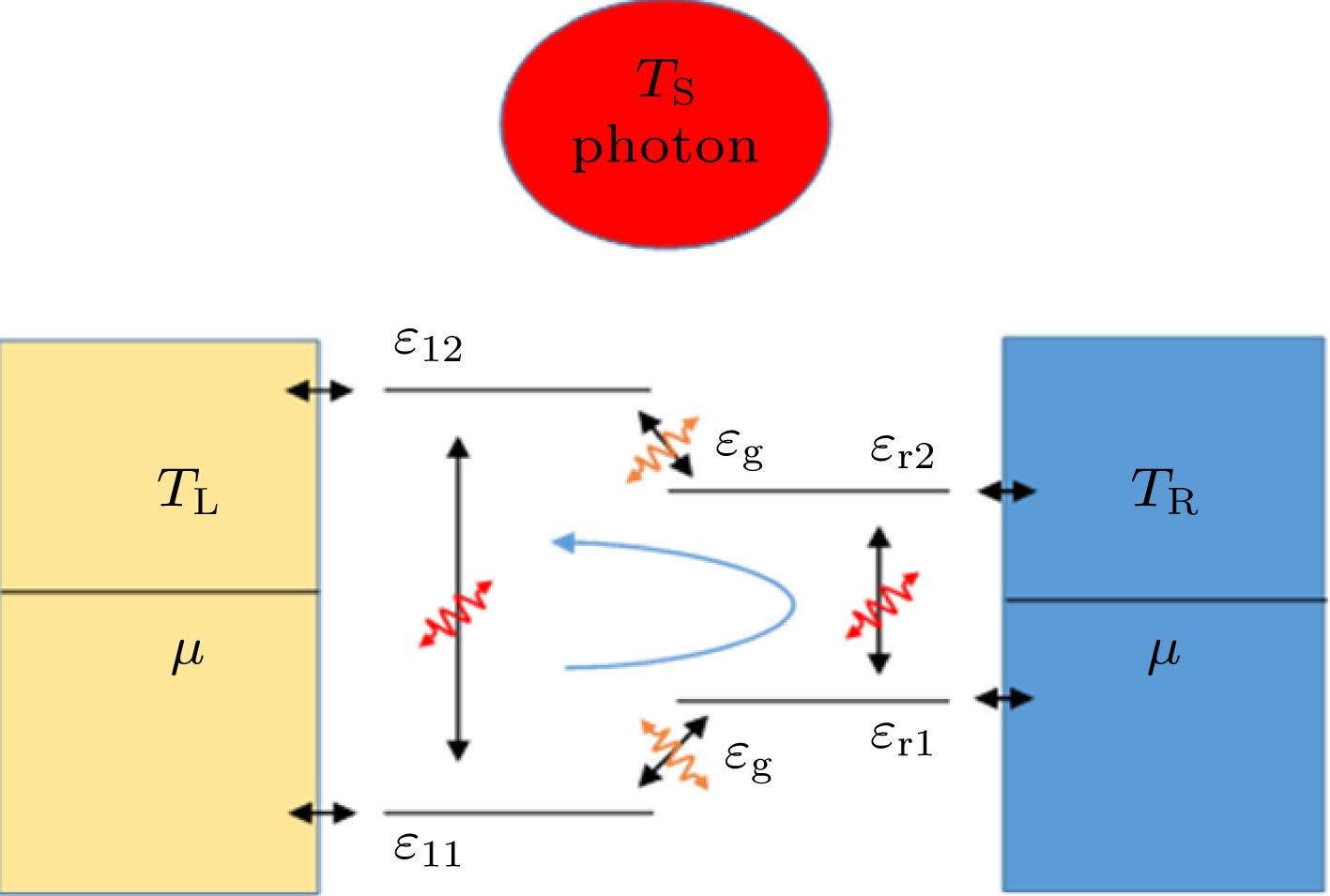
 下载:
下载:
